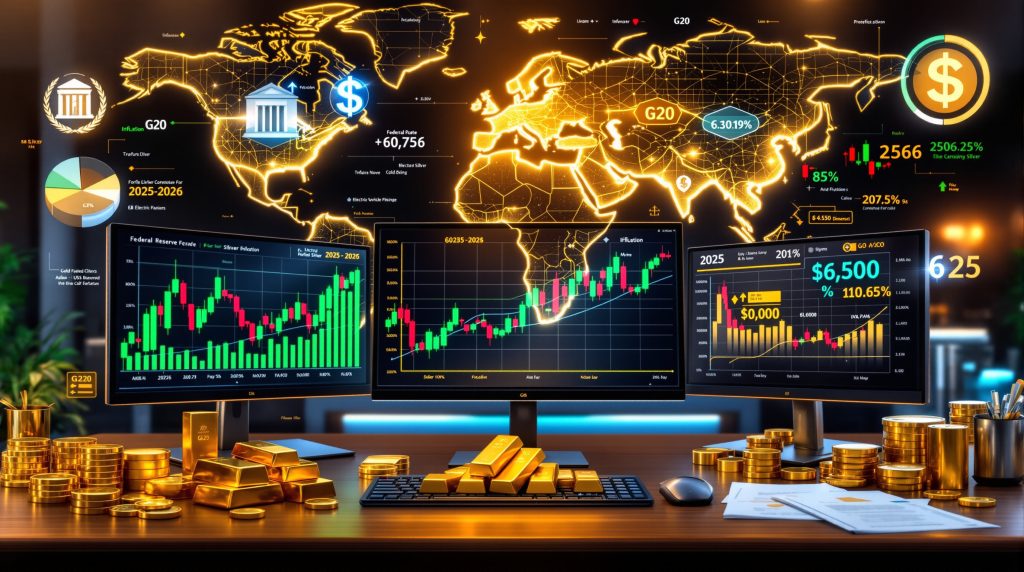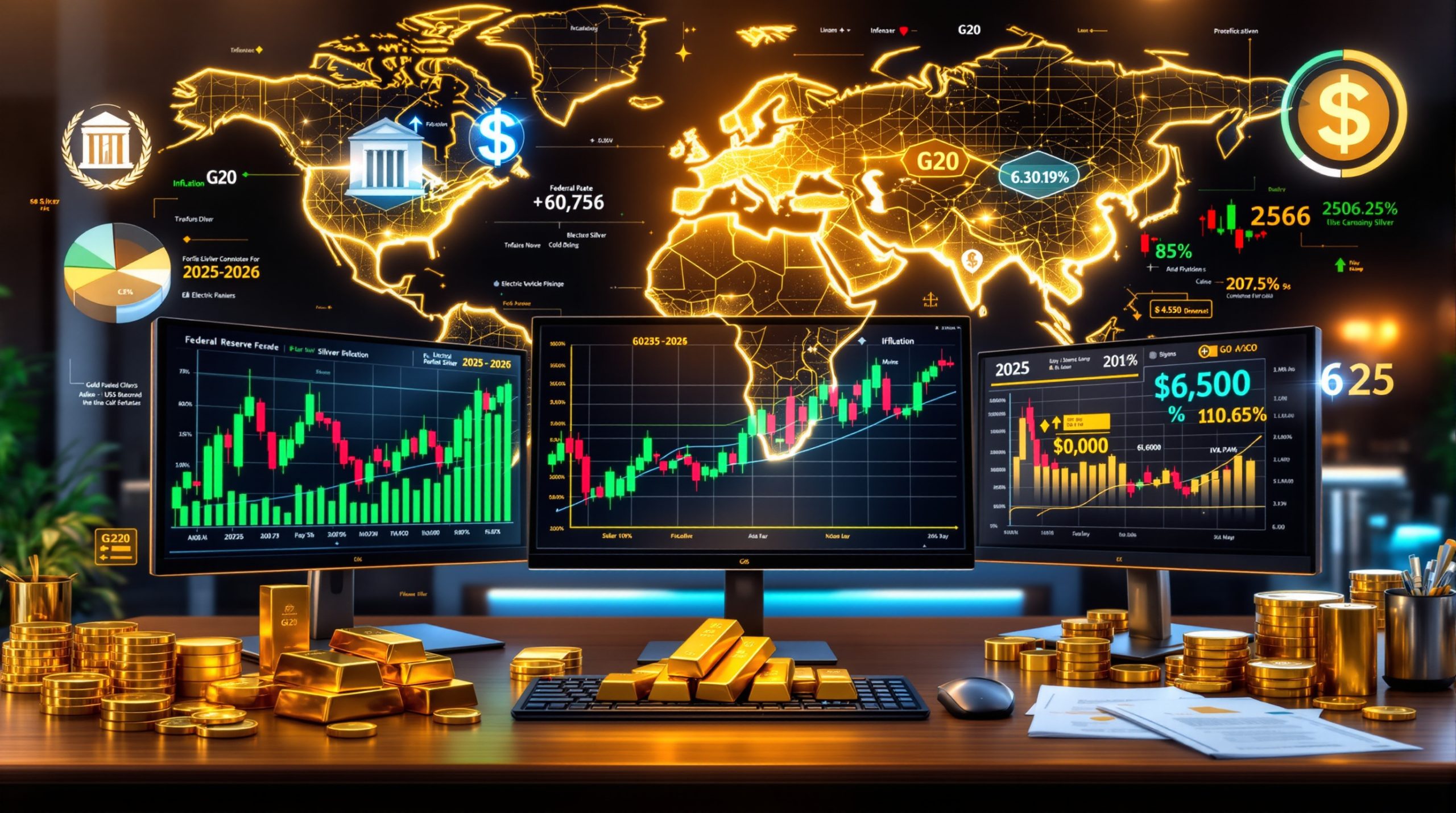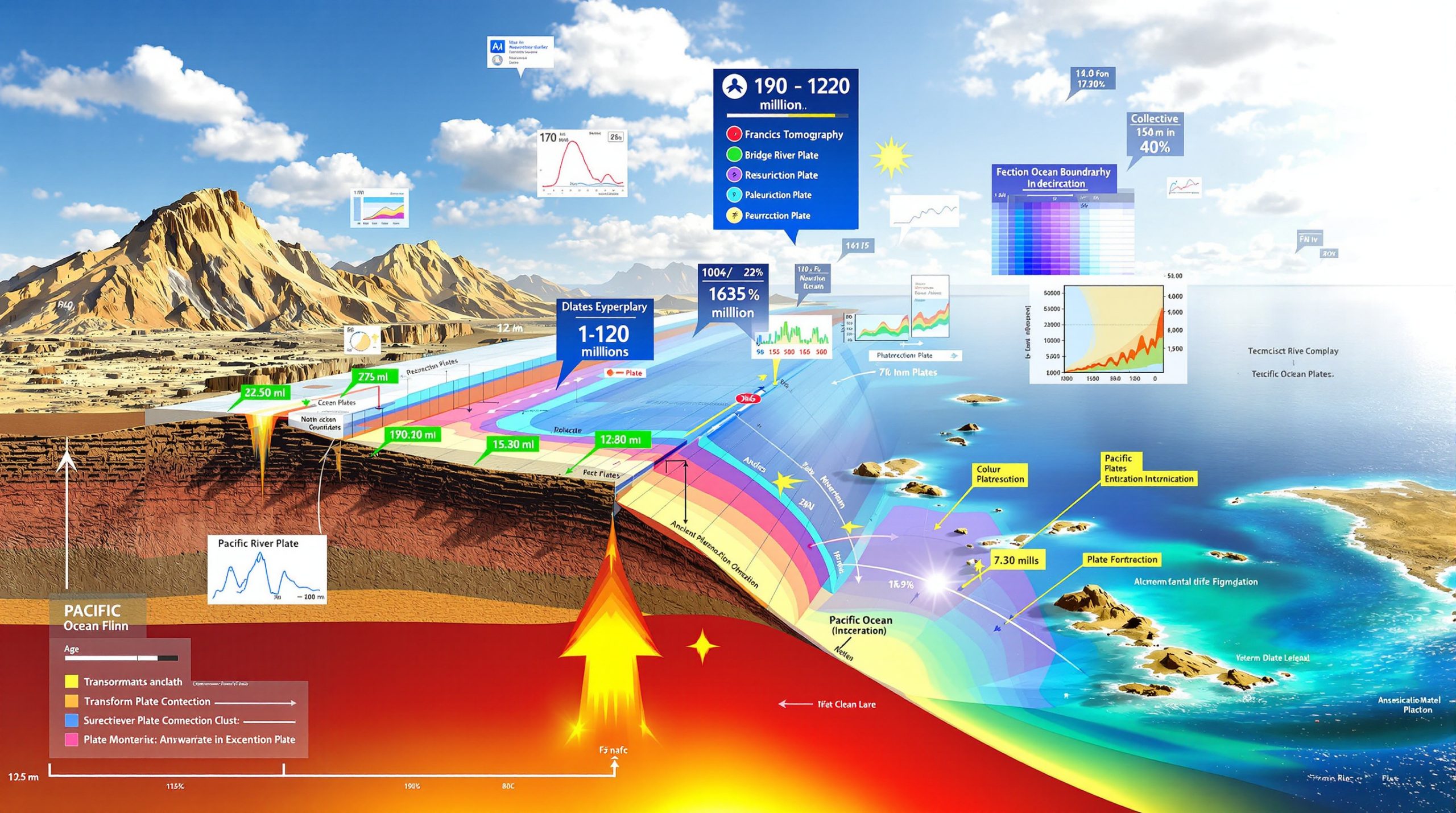Economic Indicators Signal New Phase of Precious Metals Growth
Macroeconomic forces currently reshaping global markets suggest precious metals markets are entering a transformative period. With central bank policy shifts, inflation dynamics, and manufacturing data pointing toward monetary accommodation, traditional portfolio allocation strategies require fundamental reassessment. Current market conditions reflect broader systemic changes that extend beyond typical cyclical patterns, creating investment opportunities that demand sophisticated gold and silver market analysis frameworks.
Federal Reserve Policy Trajectories and Interest Rate Impact Analysis
December 2025 Federal Reserve policy expectations indicate approximately 80% probability for a 25 basis point rate reduction, according to market-based indicators. This dovish trajectory reflects deteriorating economic conditions documented across multiple data releases, creating favourable conditions for non-yielding assets like precious metals.
Real interest rate calculations become critical in this environment. When nominal rates decline while inflation expectations remain elevated, the opportunity cost of holding gold and silver decreases substantially. Historical analysis demonstrates that precious metals perform optimally when real rates turn negative or approach zero, conditions increasingly probable given current Federal Reserve policy constraints.
The relationship between monetary policy and precious metals prices operates through multiple transmission mechanisms. Lower nominal rates reduce the yield differential between Treasury instruments and precious metals, while simultaneously signalling economic weakness that drives safe-haven demand. Current market positioning suggests investors are already anticipating these policy adjustments through precious metals accumulation.
Inflation Dynamics Reshaping Investment Allocation Strategies
Producer Price Index data reveals accelerating goods inflation, with final demand for goods rising from approximately 1% to 3% on a twelve-month basis through September 2025. This acceleration primarily reflects tariff impact analysis pressures, creating structural inflationary forces independent of traditional demand-pull mechanisms.
The divergence between goods and services inflation provides crucial insight into economic conditions. While goods prices accelerate due to trade policy impacts, wholesale services prices remained flat or declined, indicating broader economic weakness characterised by reduced business activity and employment pressures.
Consumer Price Index measurements show all-items inflation approaching 3%, with core measures (excluding food and energy) maintaining similar levels. This persistent inflation above Federal Reserve targets complicates monetary policy decisions, potentially extending the period of accommodative policy that historically benefits precious metals investors.
Consumer confidence deterioration accompanies these inflationary pressures, with spending patterns reflecting real purchasing power decline. When nominal spending increases 3% but prices rise 2%, real consumption growth of only 0.1% demonstrates the economic stress driving precious metals demand as wealth preservation vehicles.
Manufacturing Sector Contraction Signals
Richmond Federal Reserve manufacturing index declined 15% for the most recent monthly measurement, indicating significant industrial sector weakness. This deterioration extends beyond regional indicators, reflecting broader manufacturing challenges that historically correlate with precious metals strength during economic transitions.
Industrial demand for silver presents complex dynamics during manufacturing contractions. While traditional industrial applications may decline, technology sector demand continues expanding through solar panel production, electric vehicle components, and 5G infrastructure development. Furthermore, this creates supply-demand imbalances that support higher silver market squeeze conditions despite broader manufacturing weakness.
Supply chain disruptions affecting precious metals logistics create additional price pressures. Transportation bottlenecks and inventory management challenges contribute to location-specific supply constraints, even when overall market conditions remain adequately supplied. These operational inefficiencies support higher prices through increased delivery premiums and storage costs.
Global Economic Power Shifts Create New Investment Paradigms
International monetary system evolution accelerates as traditional economic arrangements face unprecedented challenges. Recent G20 meetings demonstrated growing consensus among nations representing three-quarters of global population and two-thirds of world GDP regarding coordinated policy approaches that exclude United States participation. This fundamental shift in global economic governance creates structural demand for alternative reserve assets.
De-Dollarisation Trends and Central Bank Behaviour
Central bank gold accumulation patterns reflect systematic diversification away from dollar-denominated reserves. Official sector purchases continue at elevated levels as monetary authorities seek alternatives to traditional reserve currencies. This trend intensifies as geopolitical tensions create incentives for reserve diversification beyond historical norms.
The United States' declining share of global GDP, from approximately 44% in the 1980s to roughly 22% currently, demonstrates the mathematical inevitability of monetary system evolution. As economic weight shifts toward emerging economies, reserve currency composition must eventually reflect these new realities, creating structural demand for politically neutral assets like gold.
International settlement mechanisms increasingly bypass traditional dollar-based systems. While not yet substantial enough to threaten dollar dominance, these alternative frameworks establish infrastructure for non-dollar transactions that could expand rapidly during crisis conditions or policy conflicts.
Trade War Consequences on Commodity Pricing Structures
Chinese export data illustrates trade reorientation impacts on global commerce. While Chinese exports to the United States declined 27% in September 2025, global Chinese exports increased 8.7% overall, indicating successful market diversification away from restricted destinations toward more receptive trading partners.
This trade pattern reshaping creates inflationary pressures in tariff-imposing countries while providing cost advantages to nations maintaining normal trade relationships. The resulting price differentials create arbitrage opportunities and currency pressures that historically drive precious metals investment during periods of trade disruption.
Tariff-induced goods inflation, documented through Producer Price Index acceleration, demonstrates how trade policy directly translates into domestic price pressures. These policy-driven inflation sources prove more persistent than demand-driven inflation, creating extended periods of precious metals-favourable conditions.
Currency Debasement Acceleration Across Major Economies
United States federal debt accumulation from less than $1 trillion in 1979 to $38 trillion currently represents a 38-fold increase over approximately 45 years. This debt trajectory, combined with persistent fiscal deficits, creates mathematical pressures for currency debasement through monetary accommodation.
International reserve diversification accelerates as fiscal sustainability concerns mount across developed economies. Sovereign wealth funds and central banks increasingly seek assets with no counterparty risk, driving institutional demand for physical precious metals as portfolio insurance against monetary system instability.
The relationship between fiscal expansion and precious metals prices operates through multiple channels. Direct currency debasement reduces purchasing power of paper assets, while debt service requirements create political pressure for financial repression through artificially low interest rates that benefit hard asset holders.
Technical and Market Structure Factors Drive Current Price Action
Current precious metals markets demonstrate classic consolidation patterns within uptrending secular bull markets. Gold trading ranges between $4,000-$4,100 support and $4,200+ resistance levels reflect institutional accumulation at lower ranges and profit-taking at higher levels, creating sideways volatility within longer-term upward trajectories.
Gold Market Consolidation Patterns and Breakout Scenarios
December delivery contract mechanics create near-term price pressures as physical settlement approaches. Gold futures markets typically experience increased volatility during delivery months as speculative positions close and commercial interests take physical delivery. Current conditions suggest potential upward pressure into delivery settlement.
Price Target Analysis Based on Current Market Structure:
| Scenario | Price Target | Probability Assessment | Timeline Expectation |
|---|---|---|---|
| Conservative Breakout | $4,200-$4,400 | 65% | Q1 2026 |
| Moderate Bull Extension | $4,500-$4,800 | 25% | Q2 2026 |
| Crisis-Driven Acceleration | $5,000+ | 10% | Extended 2026 |
Technical momentum indicators suggest consolidation completion may precede significant directional moves. Historical precious metals analysis of similar consolidation patterns within secular bull markets indicates breakouts typically sustain for multiple quarters once resistance levels are definitively breached.
Seasonal patterns support potential strength into early 2026. Precious metals markets often demonstrate increased institutional investment during first quarter periods as portfolio managers rebalance allocations following year-end distributions and tax-related selling pressure subsides.
Silver's Industrial Demand Revolution and Supply Constraints
Silver market dynamics reflect dual monetary and industrial demand pressures creating unique supply-demand imbalances. Industrial applications continue expanding through green energy infrastructure development while investment demand increases due to monetary system concerns, creating multiple demand drivers supporting higher prices.
Industrial Demand Sector Analysis:
• Solar Panel Manufacturing: Represents approximately 40% of total industrial silver demand, with global capacity expansion targets requiring sustained high consumption levels
• Electric Vehicle Components: Expanding battery technology and electrical systems increase silver intensity per vehicle produced
• 5G Infrastructure Development: Communications equipment requires significant silver content for electrical conductivity applications
• Medical and Antimicrobial Applications: Healthcare industry adoption continues expanding for surgical instruments and infection control systems
Supply-side constraints compound demand pressures through limited primary mine production capacity and recycling bottlenecks. Unlike gold, where above-ground stocks provide substantial supply buffers, silver's industrial consumption permanently removes material from available supplies, creating tighter long-term supply-demand balances.
Market misinformation regarding physical shortages requires careful analysis. While locational supply problems create delivery delays and premium increases, overall market conditions remain adequately supplied. Price movements reflect investment demand variations rather than fundamental supply shortages, though this distinction becomes less relevant during sustained demand increases.
Gold-Silver Ratio Dynamics and Relative Value Opportunities
Current gold-silver ratio measurements provide insight into relative value positioning between the two primary monetary metals. Historical analysis suggests silver outperforms gold during precious metals bull market acceleration phases, while gold provides better stability during correction periods.
Industrial demand growth for silver creates different price dynamics compared to gold's purely monetary demand drivers. This fundamental difference suggests silver may demonstrate higher volatility but potentially superior returns during sustained precious metals bull markets, particularly when industrial demand coincides with monetary system stress.
Portfolio optimisation strategies should consider correlation patterns between gold and silver during different market environments. While both metals generally move in the same direction, timing and magnitude differences create opportunities for tactical allocation adjustments based on ratio analysis and fundamental demand drivers.
Risk Management Strategies for Current Market Environment
Recession probability modelling indicates significant likelihood of economic contraction within 12-24 months, based on current data deterioration across multiple indicators. Historical analysis of precious metals performance during recession periods demonstrates complex relationships dependent on recession causes, policy responses, and broader market conditions.
Recession Probability Modelling and Precious Metals Performance
Historical Precious Metals Performance During Economic Contractions:
| Period | Gold Performance | Silver Performance | Economic Context |
|---|---|---|---|
| 1979-1981 | +350% peak | +800% peak | High inflation, energy crisis, monetary crisis |
| 1990-1991 | -15% during | -25% during | Real estate recession, Gulf War |
| 2001-2002 | +25% through cycle | +15% through cycle | Tech bubble, early monetary expansion |
| 2007-2011 | +170% peak | +440% peak | Financial crisis, quantitative easing programmes |
| 2019-2025 | +85% to date | +150% to date | Pandemic response, fiscal expansion |
Current conditions most closely resemble 1970s-early 1980s patterns, with persistent inflation, geopolitical tensions, and monetary system stress. However, key differences include more sophisticated financial markets, established central bank intervention capabilities, and different demographic and debt structures that may alter traditional recession-precious metals relationships.
Unlike the early 1980s experience where precious metals declined during recession, current conditions suggest prices may continue rising through economic contraction due to monetary policy constraints and fiscal response requirements. Central bank inability to raise rates sufficiently to combat inflation while maintaining financial stability creates conditions favouring continued precious metals strength.
Portfolio Diversification Through Precious Metals Allocation
Strategic Allocation Framework by Risk Profile:
• Conservative Portfolios (Low Risk Tolerance): 5-10% precious metals allocation provides portfolio insurance without excessive volatility impact
• Moderate Risk Profiles (Balanced Approach): 10-15% allocation optimises risk-adjusted returns while maintaining diversification benefits
• Aggressive Hedge Positions (High Risk Tolerance): 15-25% maximum allocation captures upside potential while maintaining portfolio balance
Implementation methodology considerations include physical storage versus exchange-traded fund exposure, mining equity allocation for enhanced return potential, and options strategies for income generation or downside protection. Each approach presents different risk-return profiles requiring careful evaluation based on individual circumstances and market conditions.
Physical vs. Financial Precious Metals Exposure:
Physical bullion ownership provides ultimate counterparty risk elimination but involves storage costs, insurance requirements, and liquidity constraints. Exchange-traded funds offer liquidity and convenience while introducing counterparty risk and potential tracking errors during extreme market conditions.
Mining equity exposure amplifies precious metals price movements through operational leverage but introduces company-specific risks including management quality, geological challenges, and regulatory issues. Optimal mining equity selection requires fundamental analysis beyond simple precious metals price correlation.
Timing Entry and Exit Strategies in Volatile Markets
Dollar-cost averaging strategies provide systematic accumulation methods that reduce timing risk while building positions over extended periods. This approach proves particularly effective during consolidation phases when prices demonstrate high volatility within established trading ranges.
Technical Analysis Framework for Entry Timing:
• Support Level Testing: Accumulate positions when prices approach established support zones with volume confirmation
• Breakout Confirmation: Add to positions following decisive breaks above resistance levels with sustained volume
• Momentum Divergence Signals: Monitor technical indicators for early warning signs of trend changes or continuation patterns
Profit-taking strategies require discipline during parabolic price advances. Historical analysis suggests precious metals bull markets often conclude with rapid price acceleration followed by sharp corrections, creating opportunities for tactical position reduction and subsequent reaccumulation at lower levels.
Geopolitical Developments Influence Long-Term Pricing Trends
Military conflicts and international tensions continue creating safe-haven demand for precious metals as portfolio insurance against geopolitical risks. Current global flashpoints span multiple regions, from Eastern European conflicts to Middle Eastern tensions and Asian territorial disputes, creating persistent uncertainty that supports precious metals investment demand.
Military Conflicts and Safe-Haven Demand Patterns
Ukraine-Russia conflict implications extend beyond immediate regional impacts through energy market disruption, grain supply constraints, and NATO alliance testing. These effects create persistent risk premiums in global markets that benefit safe-haven assets like precious metals throughout conflict duration.
Middle East tensions affect global energy supplies and trade route security, particularly through strategic shipping channels controlling significant percentages of global commerce. Disruption threats to Suez Canal or Persian Gulf shipping create risk premiums that benefit precious metals as hedges against supply chain interruption and energy price volatility.
Taiwan strait concerns represent potentially the most significant geopolitical risk given the concentration of global semiconductor production and strategic importance to both Chinese and American interests. Any escalation in tensions creates technology supply chain risks and currency instability that historically drive precious metals demand.
Sanctions Regimes and Alternative Payment Systems
International sanctions implementation creates incentives for alternative settlement mechanisms that bypass traditional dollar-based systems. While current alternatives remain limited in scope, infrastructure development continues expanding capacity for non-dollar international transactions during crisis periods.
SWIFT alternative development by major economies creates redundant international payment capabilities that reduce dependence on Western-controlled financial infrastructure. Gold settlement mechanisms gain importance as politically neutral alternatives when traditional payment systems face restrictions or sanctions risks.
Cryptocurrency adoption presents complex relationships with precious metals demand. While both represent alternatives to traditional monetary systems, cryptocurrencies face regulatory restrictions and technical limitations that maintain precious metals advantages during crisis conditions requiring maximum reliability and universal acceptance.
Resource Nationalism and Mining Industry Consolidation
Government intervention risks in major precious metals producing countries create supply uncertainty that supports higher prices through risk premium incorporation. Recent trends toward resource nationalism in mining jurisdictions create long-term supply constraints as project development becomes more complex and expensive.
Environmental regulation impacts on mining operations increase production costs while restricting new project development. These regulatory trends, while environmentally beneficial, create supply-side pressures supporting higher precious metals prices through increased marginal production costs.
Indigenous rights considerations affect mining project permitting and development timelines, particularly in major producing regions. Social licence requirements add complexity and costs to mining operations while potentially restricting supply growth during periods of increasing demand.
Technology and Innovation Shape Future Demand Patterns
Green energy transition requirements create structural demand for silver through solar panel manufacturing and electrical grid modernisation. Global renewable energy capacity targets require sustained high silver consumption for photovoltaic cell production and electrical infrastructure development supporting clean energy systems.
Green Energy Transition Silver Requirements
Solar Industry Growth Impact on Silver Demand:
Global solar capacity expansion targets through 2030 require approximately 20% of total silver production annually for photovoltaic applications. Silver intensity per megawatt installed continues increasing as efficiency improvements require higher purity and conductivity specifications.
Recycling Technology Development Timeline:
Current solar panel recycling capabilities remain limited, with most installed capacity approaching end-of-life phases in coming decades. Silver recovery technology improvements may eventually provide secondary supply sources, but implementation timelines extend beyond current demand growth requirements.
Electric vehicle adoption creates additional silver demand through battery systems, electrical components, and charging infrastructure development. Each electric vehicle requires significantly more silver than traditional internal combustion engines, creating sustained demand growth as automotive industry transitions toward electrification.
Digital Currency Competition and Store-of-Value Preferences
Bitcoin versus gold institutional adoption patterns demonstrate generational and philosophical differences in store-of-value preferences. While cryptocurrencies attract technology-oriented investors, precious metals maintain advantages in crisis situations requiring maximum reliability and universal acceptance without technical dependencies.
Central Bank Digital Currency development creates complex implications for precious metals demand. While CBDCs may reduce cash usage, they also demonstrate central bank capabilities for monetary control and surveillance that may increase demand for assets providing privacy and independence from official monetary systems.
Generational wealth preservation preferences show interesting patterns with younger investors initially favouring digital assets but increasingly recognising precious metals benefits as market experience accumulates. This learning curve suggests eventual convergence toward diversified approaches including both digital and physical alternative assets.
Advanced Manufacturing Applications for Precious Metals
Aerospace industry demand evolution continues expanding through satellite technology, space exploration programmes, and advanced propulsion system development. These applications require specific precious metals properties for extreme environment performance, creating specialised demand segments with limited substitution possibilities.
Medical device innovation requirements increase precious metals consumption through biocompatible applications, precision instruments, and antimicrobial treatments. Healthcare industry growth combined with technological advancement creates sustained demand growth for specialised precious metals applications.
Quantum computing component necessities represent emerging demand sources requiring ultra-pure precious metals for superconducting applications and electromagnetic shielding. While current volumes remain limited, potential future expansion could create significant new demand categories as quantum technologies achieve commercial viability.
Current Market Environment Analysis and Strategic Implications
Current market conditions demonstrate characteristics similar to late 1970s precious metals environments while incorporating unique elements requiring updated analytical frameworks. Key similarities include persistent inflation pressures, geopolitical tensions, and currency debasement concerns, while critical differences involve financial market sophistication, central bank intervention capabilities, and global economic integration levels.
Historical Pattern Recognition and Current Distinctions
Late 1970s Similarities:
• Rising inflation pressures and currency debasement through fiscal expansion
• Geopolitical tensions creating international uncertainty and safe-haven demand
• Energy price volatility affecting global economic stability and trade patterns
• Central bank policy constraints limiting traditional monetary policy effectiveness
Critical Differences from Historical Precedent:
• Financial market sophistication provides multiple hedging alternatives beyond precious metals
• Central bank intervention capabilities include quantitative easing and direct market support mechanisms
• Global economic integration creates complex interdependencies affecting crisis transmission and resolution
• Technology sector influence on economic growth patterns differs substantially from historical manufacturing-based economies
Market Correction Risk Assessment and Positioning
Correction probability analysis suggests temporary price weakness remains possible during short-term profit-taking phases, particularly at psychological resistance levels and during seasonal weakness periods. However, fundamental demand drivers appear sufficiently strong to support higher prices over extended time horizons.
Seasonal Pattern Considerations:
Historical analysis indicates precious metals often experience weakness during late spring and early summer periods as investment demand typically declines during economic growth optimism phases. However, current structural issues may override seasonal patterns if economic conditions continue deteriorating.
Profit-Taking Behaviour at Psychological Levels:
Gold approaching $4,200 and silver above $50 represent psychological resistance points where profit-taking typically increases. These levels may generate temporary corrections providing accumulation opportunities for longer-term strategic positioning.
Bull Market Sustainability Assessment
Current bull market phase analysis indicates early-to-middle stages of precious metals secular uptrend based on fundamental driver sustainability and technical momentum patterns. Unlike speculative bubble characteristics, current price appreciation reflects rational responses to monetary system stress and economic uncertainty.
Fundamental Driver Sustainability Evaluation:
Debt trajectory mathematics, geopolitical tension persistence, and technology demand growth create multiple sustainable demand drivers unlikely to resolve quickly. This combination suggests extended bull market duration compared to cyclical precious metals rallies driven by temporary factors.
Technical Momentum Indicator Assessment:
Long-term technical indicators demonstrate sustained upward momentum without excessive speculative characteristics typical of bull market terminal phases. Current consolidation patterns suggest healthy market structure development supporting future price advancement.
Investment Implementation and Strategic Action Framework
Building precious metals positions in current market conditions requires systematic approaches balancing opportunity capture with risk management through volatile market environments. Successful implementation combines technical analysis timing with fundamental allocation strategies adapted to individual risk tolerance and investment objectives.
Phased Position Building in Current Market Environment
Initial Allocation Establishment (3-5% Portfolio Weight):
Begin with conservative allocation percentages providing precious metals exposure without excessive portfolio impact during initial position establishment. This foundation approach allows familiarity development with precious metals market behaviour while maintaining overall portfolio stability.
Dollar-Cost Averaging Implementation (6-12 Month Accumulation Period):
Systematic accumulation over extended periods reduces timing risk while building positions during market volatility. Weekly or monthly purchase schedules provide consistent accumulation regardless of short-term price fluctuations, optimising average entry prices over time.
Opportunistic Addition Strategy (Weakness-Based Accumulation):
Reserve capital for temporary price weakness periods when fundamental conditions remain supportive but short-term technical or sentiment factors create accumulation opportunities. This approach requires patience and discipline but often produces superior long-term returns.
Economic Indicator Monitoring for Portfolio Management
Critical Federal Reserve Policy Indicators:
• FOMC Meeting Minutes Analysis: Monitor policy statement language changes indicating dovish or hawkish bias shifts
• Federal Reserve Economic Projections: Track dot plot interest rate expectations and economic growth forecasts
• Fed Chair Congressional Testimony: Analyse prepared remarks and question responses for policy direction insights
Inflation Measurement Tracking:
• Consumer Price Index Releases: Monitor both headline and core measurements for trend identification
• Producer Price Index Data: Track goods versus services inflation divergence patterns
• Personal Consumption Expenditures Index: Federal Reserve preferred inflation measure requiring close attention
International Economic Development Monitoring:
• Central Bank Gold Purchase Announcements: Track official sector accumulation patterns for demand trend analysis
• Currency Exchange Rate Movements: Monitor dollar strength relative to major trading partner currencies
• International Trade Balance Reports: Assess global trade pattern shifts affecting currency and commodity demand
Professional Advisory Resources and Research Access
Independent precious metals research services provide specialised market analysis beyond general financial media coverage. Organizations like CPM Group offer detailed quarterly and annual market studies examining supply-demand fundamentals, price forecasting models, and investment strategy recommendations.
Certified Financial Planner consultation becomes valuable for precious metals allocation integration within comprehensive financial planning frameworks. Professional guidance helps optimise allocation percentages based on individual circumstances while considering tax implications and estate planning considerations.
Tax Optimisation Strategies for Precious Metals Investments:
• IRA and 401(k) Integration: Utilise retirement account precious metals options for tax-advantaged accumulation
• Capital Gains Planning: Structure purchases and sales timing to optimise tax efficiency
• Estate Planning Considerations: Incorporate precious metals storage and inheritance planning into overall estate management
Furthermore, investors can benefit from understanding gold strategic investment approaches during current economic conditions. Additionally, monitoring US economic indicators provides valuable context for precious metals investment decisions.
Investment Disclaimer: This analysis represents educational information only and should not be considered personalised investment advice. Precious metals investments carry significant risks including price volatility, storage costs, and potential losses. Consult qualified financial professionals before making investment decisions. Past performance does not guarantee future results, and all economic forecasts involve substantial uncertainty.
Further Research Resources: Investors seeking comprehensive precious metals market analysis can access additional educational content through the World Gold Council, Silver Institute, and various independent research organisations providing regular market commentary through current precious metals pricing data and fundamental analysis for informed investment decision-making.
Ready to Capitalise on the Next Major Precious Metals Discovery?
Discovery Alert's proprietary Discovery IQ model delivers real-time alerts on significant ASX mineral discoveries, instantly transforming complex market data into actionable insights for precious metals investors. Join thousands of subscribers who have gained a market-leading advantage by accessing historic discovery examples and beginning their 30-day free trial at Discovery Alert today.




